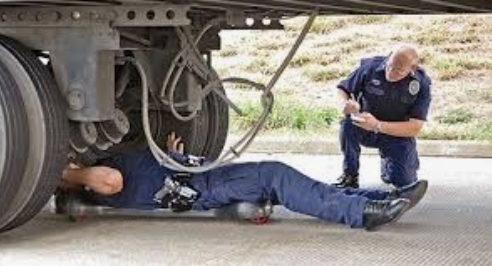



Conducting a proper pre-trip inspection (PTI) of your equipment will help protect the general public, your CDL, and spot potential hazards which could later leave you on the side of the road or worse. Irregardless of the fact your annual DOT inspection(s) are current it is vital that you perform a pre-trip inspection (PTI) daily to ensure the safe operation of your equipment which in turn puts you in control of a road worthy vehicle and passing a DOT Inspection in the event it happens. What should you check for during a pre-trip inspection? Here is a brief overview.
Check the tires, their sidewalls, tire treads, and wheel fasteners to make sure they are in good condition, there should not be any rust or cracks on the wheels, and all tires must be properly inflated.
Push-rods must be working properly, measure the length by which they travel when you press down on the brakes, this method is used for brake measurements during a DOT inspection. Be certain the u-joints and all other components are functioning properly and nothing is broken, bent, loose or missing.
It’s also essential to ensure the kingpin locking jaw is functioning. Check the leaf springs and shackles to ensure there are no cracks in the mounting device or other components.
You also need to look out for any grease and oil covering the steering system or leaking, these are some of the things DOT Inspectors write violations for.
Make sure there are no parts and components missing that could compromise your safety, the safety of your vehicle and the safety of the public. Any mismatched slack adjusters or brake canisters can also lead to a failed DOT Inspection if their not functioning properly. The same holds true for a broken spring the axle suspension system.
A few other things you must check, include:
A post-trip inspection works exactly as a pre-trip inspection which briefly includes the following:
Conducting proper Pre/Post-Trip Inspections daily can help ensure your safety, public safety, vehicle safety/functionality and avoiding failed DOT Inspections or worse being placed Out Of Service. Remember DOT Inspectors do not inspect only trucks and trailers they also inspect you, so be mindful driver fitness is paramount. Understanding the type of person operating the equipment helps the DOT gauge whether he/she is likely to keep the equipment in optimal road worthy condition that ensures total safety. Many steps in the process was not mentioned on purpose since this blog by no means is meant to be the totality of a proper DOT Pre/Post Trip Inspection, the purpose here was to provide you with a brief overview of the process. For the complete guide on performing proper Pre/Post-Trip Inspections refer to the Federal Motor Carrier Safety Regulations book or visit www.fmcsa.dot.gov
Written by: Fr8 World Logi$tix.